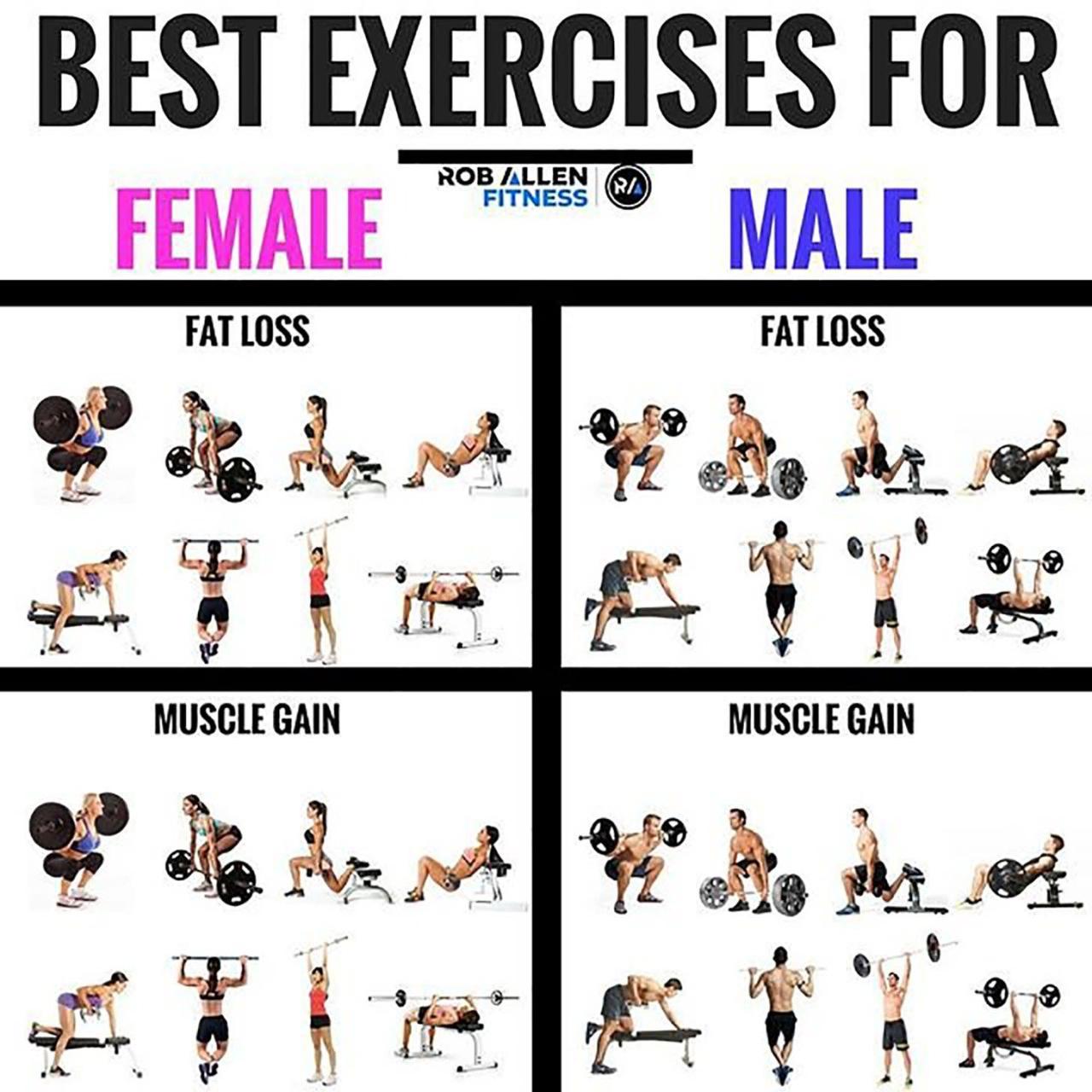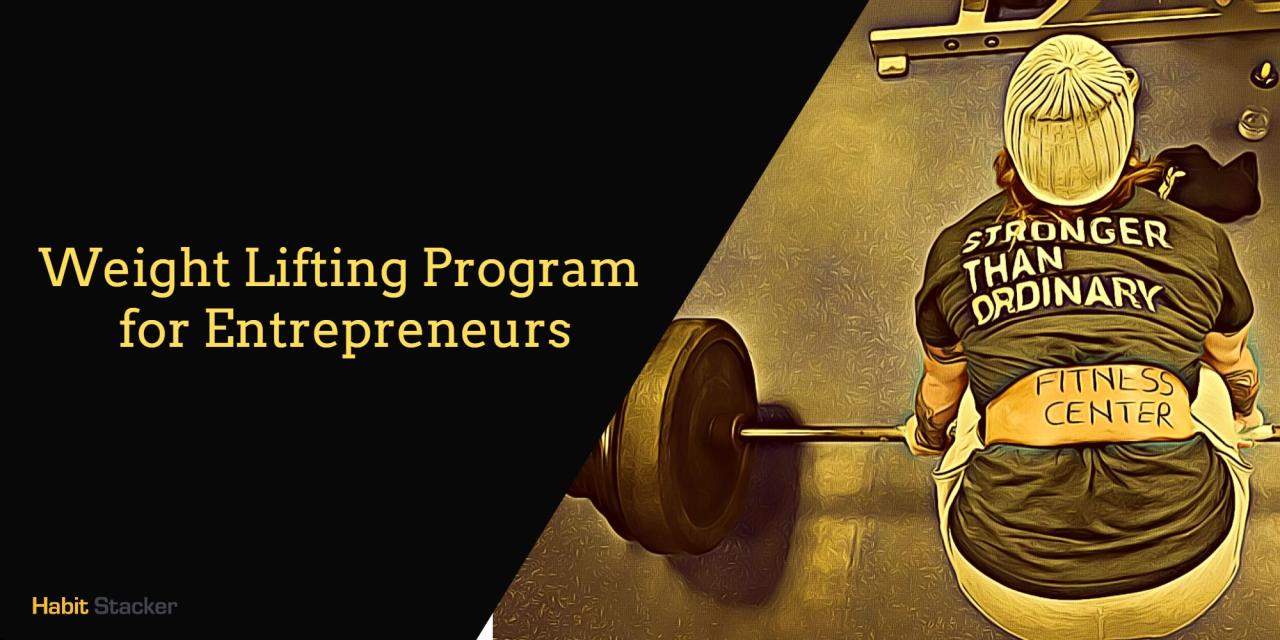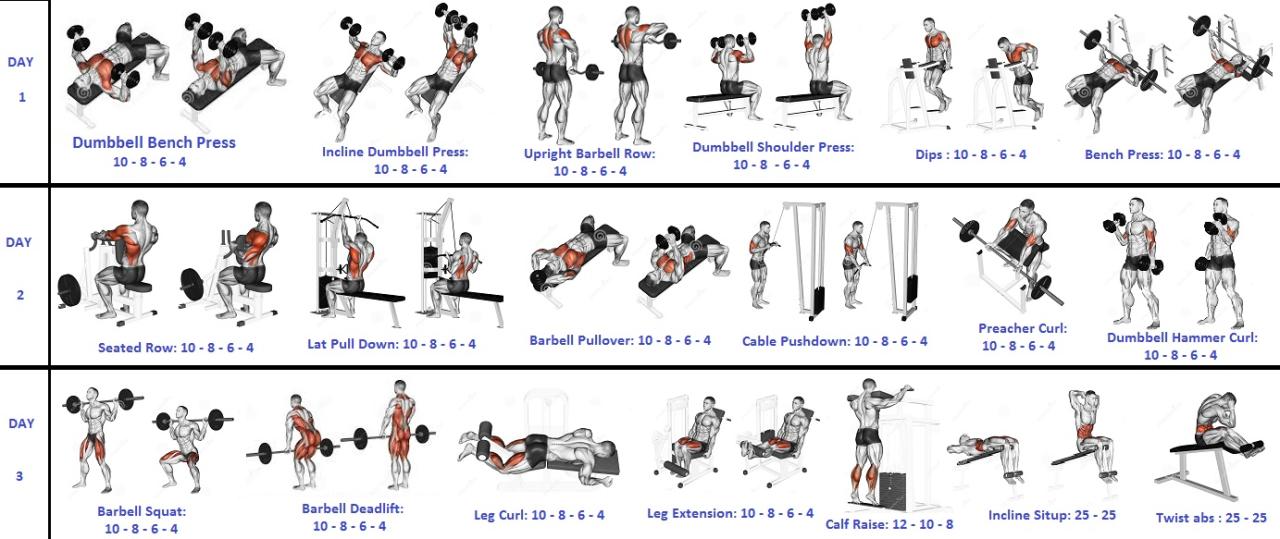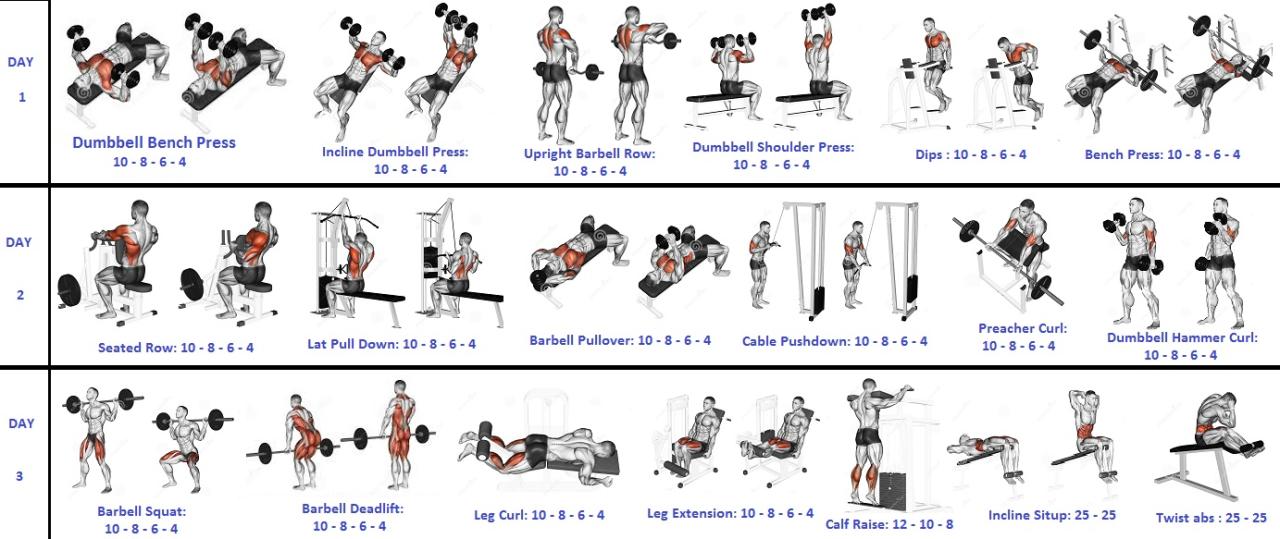Effective weight lifting routines for building muscle mass quickly aren’t just about grunting and groaning; they’re a carefully orchestrated symphony of science, strategy, and sheer willpower. This isn’t your grandpa’s bicep curl – we’re diving deep into the physiological processes that sculpt muscle, exploring the hormonal heroes (hello, testosterone!), and crafting programs that’ll have you adding inches to your frame faster than you can say “gains.” Prepare to unleash your inner muscle-bound marvel!
We’ll dissect the science behind muscle growth, detailing the roles of hormones and different muscle fiber types. Then, we’ll arm you with customizable workout plans tailored to your experience level, from beginner-friendly 12-week programs to advanced 8-week routines incorporating techniques like drop sets and supersets. We’ll cover nutrition strategies to fuel your gains, recovery methods to prevent burnout, and the common pitfalls to avoid so you don’t end up sidelined with an injury or stalled progress.
Get ready to transform your physique and conquer your fitness goals!
Understanding Muscle Growth Principles

Building muscle isn’t just about lifting heavy things; it’s about understanding the intricate dance your body performs at a cellular level. Think of it as a finely-tuned engine, and we’re learning how to supercharge it. This section delves into the fascinating science behind muscle growth, so you can optimize your workouts for maximum gains.Muscle hypertrophy, the glorious process of muscle growth, is essentially the enlargement of muscle fibers.
This isn’t just adding more fibers; it’s about making existing fibers thicker and stronger. This happens through a complex interplay of protein synthesis (building new muscle proteins) and protein breakdown (removing damaged proteins). The key is to tip the scales in favor of synthesis, leading to a positive muscle protein balance – more building than breaking down.
This is achieved through strategic weight training and proper nutrition.
The Hormonal Symphony of Muscle Growth
Hormones are the body’s chemical messengers, and certain ones play starring roles in muscle growth. Testosterone, the quintessential “muscle-building” hormone, stimulates protein synthesis and increases muscle fiber size. Growth hormone (GH) also contributes significantly, promoting cell growth and regeneration, including muscle tissue. Think of these hormones as the conductors of an orchestra, coordinating the intricate processes that lead to muscle hypertrophy.
Sufficient sleep and low stress levels are crucial for optimal hormone production. Insufficient sleep can dramatically impact testosterone and GH levels, hindering muscle growth.
Muscle Fiber Types and Their Roles in Weightlifting
We’re not all built the same, and this is reflected in the different types of muscle fibers we possess. Type I fibers, also known as slow-twitch fibers, are endurance champions, efficient at using oxygen for sustained contractions. Type II fibers, or fast-twitch fibers, are powerhouses, generating explosive force but fatiguing quickly. Type II fibers are further subdivided into Type IIa (fast-oxidative glycolytic) and Type IIx (fast-glycolytic), each with varying capabilities.
Weightlifting primarily targets Type II fibers, leading to increased size and strength. However, incorporating exercises that engage Type I fibers can improve overall fitness and recovery. For example, a powerlifter will primarily focus on Type II fibers, while a marathon runner will predominantly use Type I fibers.
Want to pack on muscle faster than a cheetah on caffeine? Effective weight lifting routines for building muscle mass quickly hinge on smart programming. But don’t forget the foundation: incorporating solid muscular strength exercises is key to building that base of power before you start piling on the pounds. Ultimately, the best weight lifting routines combine strategic muscle building with a strong foundation of strength training for optimal gains.
Progressive Overload: The Key to Consistent Muscle Growth
Imagine trying to build a skyscraper without adding more bricks. Sounds impossible, right? Progressive overload is the equivalent of adding those bricks in the weightlifting world. It simply means consistently challenging your muscles by gradually increasing the weight, reps, or sets over time. This constant stimulus forces your muscles to adapt and grow stronger, preventing plateaus and maximizing muscle growth.
A classic example would be starting with a bench press of 100 lbs for 8 reps, then progressively increasing to 105 lbs, then 110 lbs, and so on. This consistent challenge is crucial for long-term muscle growth. Ignoring progressive overload is like expecting your muscles to magically grow stronger without providing them with the necessary stimulus.
Designing Effective Weightlifting Programs
So, you want to sculpt yourself into a Greek god (or goddess, let’s not be biased!)? Building muscle takes dedication, smart planning, and maybe a little less time spent on the couch. Forget those fad diets and miracle pills – let’s talk about creating a weightlifting program that’ll actually get you results. We’ll cover everything from beginner-friendly routines to advanced techniques, ensuring you’re equipped to conquer your fitness goals.
Prepare for some serious gains!
Want to sculpt a physique that would make Michelangelo weep with envy? Effective weight lifting routines for building muscle mass quickly are key, but let’s be honest, sometimes you need a little extra guidance. That’s where a personalized weight training plan for building muscle and losing fat comes in handy – ditch the guesswork and get those gains! Then, armed with a tailored plan, you can conquer those effective weight lifting routines and watch your muscles sprout like magic mushrooms.
A 12-Week Beginner Weightlifting Program
This program focuses on compound movements to build a solid foundation of strength and muscle mass. Remember, proper form is paramount! Don’t sacrifice form for weight; it’s far better to lift lighter with perfect technique than to risk injury.
| Day | Exercise | Sets | Reps | Rest (seconds) |
|---|---|---|---|---|
| Monday | Squats | 3 | 8-12 | 60-90 |
| Monday | Bench Press | 3 | 8-12 | 60-90 |
| Monday | Bent-Over Rows | 3 | 8-12 | 60-90 |
| Wednesday | Deadlifts | 1 | 5 | 120-180 |
| Wednesday | Overhead Press | 3 | 8-12 | 60-90 |
| Wednesday | Pull-ups (or Lat Pulldowns) | 3 | As many as possible (AMRAP) | 60-90 |
| Friday | Squats | 3 | 8-12 | 60-90 |
| Friday | Bench Press | 3 | 8-12 | 60-90 |
| Friday | Bent-Over Rows | 3 | 8-12 | 60-90 |
An 8-Week Intermediate Weightlifting Program with Advanced Techniques
This program introduces drop sets and supersets to challenge your muscles and stimulate further growth. Remember to listen to your body and adjust the weights as needed. Don’t be a hero; smart training is better than reckless training.
Want to sculpt a physique that would make Michelangelo jealous? Effective weight lifting routines for building muscle mass quickly involve dedication and the right plan. But if you’re a woman over 40 aiming for weight loss, check out the best strength training program for women over 40 to lose weight for a tailored approach. Then, get back to those muscle-building gains – remember, even toned muscles burn more calories, making your weight lifting even more effective!
| Day | Exercise | Sets | Reps | Rest (seconds) | Technique |
|---|---|---|---|---|---|
| Monday (Chest & Triceps) | Bench Press | 3 | 8-12 | 60 | Standard |
| Monday | Incline Dumbbell Press | 3 | 10-15 | 45 | Superset with Bench Press |
| Monday | Close-Grip Bench Press (Drop Set) | 1 | 8-12, then drop weight and continue to failure | 90 | Drop Set |
| Wednesday (Back & Biceps) | Pull-ups | 3 | AMRAP | 60 | Standard |
| Wednesday | Barbell Rows | 3 | 8-12 | 45 | Superset with Pull-ups |
| Wednesday | Bicep Curls (Drop Set) | 1 | 8-12, then drop weight and continue to failure | 90 | Drop Set |
| Friday (Legs & Shoulders) | Squats | 3 | 8-12 | 60 | Standard |
| Friday | Leg Press | 3 | 10-15 | 45 | Superset with Squats |
| Friday | Overhead Press | 3 | 8-12 | 60 | Standard |
| Friday | Lateral Raises | 3 | 12-15 | 45 | Superset with Overhead Press |
Comparing Training Splits, Effective weight lifting routines for building muscle mass quickly
Different training splits cater to different goals and recovery abilities. A full-body split works all muscle groups each workout, ideal for beginners. Upper/lower splits focus on either the upper or lower body each session, allowing for more volume. Push/pull/legs splits divide exercises based on movement patterns (pushing, pulling, leg exercises), offering a balanced approach. The best split depends on individual needs and preferences; experimentation is key!
Want to sculpt a physique worthy of a Greek god (or at least a really buff human)? Effective weight lifting routines for building muscle mass quickly require dedication, but don’t worry, you don’t need to be a seasoned lifter. If you’re starting from scratch, check out this complete beginner’s weight training program for muscle gain to build a solid foundation.
Then, you’ll be ready to tackle those more advanced, muscle-exploding routines in no time!
Incorporating Compound and Isolation Exercises
Compound exercises (like squats, deadlifts, bench press) work multiple muscle groups simultaneously, building a strong foundation. Isolation exercises (like bicep curls, triceps extensions) target specific muscles for further development and shaping. A balanced program incorporates both for optimal muscle growth – think of it as building a house: you need a strong foundation (compound exercises) before you add the finishing touches (isolation exercises).
Nutrition for Muscle Growth

Forget magic potions and mythical muscle-building elixirs! Building serious muscle requires a serious approach to nutrition. Think of your muscles as a high-performance engine – you wouldn’t fuel a Ferrari with regular unleaded, would you? The right nutrients are the key to unlocking your body’s muscle-building potential, transforming you from a scrawny sprout into a muscle-bound marvel.Macronutrient Requirements for Optimal Muscle Growth are crucial for maximizing your gains.
We’re talking about the big three: protein, carbohydrates, and fats. Getting the right balance is vital for providing your muscles with the building blocks and energy they need to grow and repair themselves after a grueling workout. Think of it as a perfectly balanced recipe for muscle growth. Too much of one ingredient, and the whole dish falls apart.
Macronutrient Ratios
The ideal macronutrient ratio for muscle growth is a hotly debated topic, but a generally accepted guideline is to consume approximately 30-40% of your daily calories from protein, 40-50% from carbohydrates, and 20-30% from fats. This ratio provides the necessary building blocks (protein), energy (carbohydrates), and essential fatty acids (fats) for optimal muscle growth and recovery. The exact percentages will vary depending on factors such as your training intensity, individual metabolism, and overall fitness goals.
Want to pack on muscle faster than a cheetah on caffeine? Effective weight lifting routines are key, focusing on compound movements and progressive overload. But finding the best routine can feel like searching for the Holy Grail of gains. That’s where a solid strength training program comes in, like the one you’ll find at best strength training program , to guide your muscle-building journey.
Remember consistency is king – and queen, if you’re feeling ambitious!
For example, a highly active individual might require a higher carbohydrate intake to fuel intense workouts.
Daily Caloric Intake for Muscle Building
Determining your daily caloric intake requires a bit of math, but it’s worth the effort. To gain muscle, you need to be in a slight caloric surplus – meaning you consume slightly more calories than you burn. A surplus of 250-500 calories per day is generally recommended for optimal muscle growth without excessive fat gain. This can be achieved by increasing your food intake or reducing your caloric expenditure through less intense exercise.
A calorie tracking app can help you monitor your intake and make adjustments as needed. Remember, consistency is key!
Example Meals and Snacks for Muscle Growth and Recovery
Proper fueling is essential for muscle growth. Here are some examples of meals and snacks that support muscle growth and recovery. Remember to adjust portion sizes based on your individual caloric needs.
- Breakfast: Oatmeal with protein powder, berries, and nuts. This provides sustained energy and protein for muscle repair.
- Lunch: Chicken breast salad sandwich on whole-wheat bread with avocado and mixed greens. A good source of lean protein and healthy fats.
- Dinner: Salmon with brown rice and steamed broccoli. Salmon is rich in omega-3 fatty acids, while brown rice and broccoli provide carbohydrates and fiber.
- Snacks: Greek yogurt with fruit, protein shake, hard-boiled eggs, almonds.
Hydration for Muscle Growth and Recovery
Water is often overlooked, but it plays a crucial role in muscle growth and recovery. Water helps transport nutrients to your muscles, aids in protein synthesis, and helps regulate body temperature during workouts. Dehydration can impair muscle function and hinder recovery. Aim to drink plenty of water throughout the day, especially before, during, and after your workouts. Consider carrying a reusable water bottle to remind yourself to stay hydrated.
Want to sculpt a physique that would make Michelangelo weep with envy? Effective weight lifting routines for building muscle mass quickly involve strategic exercises and progressive overload. But remember, building muscle isn’t just about lifting heavy; it’s about smart lifting! To truly optimize your gains, check out this guide on creating a personalized strength training program for weight loss – it’ll help you tailor your routine for maximum impact.
Then, get back to those gains, and remember, consistency is key to achieving your muscle-building dreams!
A good rule of thumb is to drink half your body weight in ounces of water daily. For example, a 150-pound individual should aim for approximately 75 ounces of water per day.
Recovery and Rest

Building muscle isn’t just about lifting heavy; it’s about giving your body the time and tools it needs to rebuild stronger. Think of your muscles as magnificent LEGO creations: you can build amazing structures, but if you don’t give them a chance to solidify, they’ll crumble. Recovery and rest are the secret sauce that transforms your gym efforts into impressive gains.
Sleep’s Role in Muscle Recovery and Growth
Sleep is more than just hitting the snooze button; it’s the ultimate muscle-building elixir. During sleep, your body releases growth hormone, a crucial player in muscle protein synthesis – the process of building new muscle tissue. Insufficient sleep disrupts this process, hindering your progress and leaving you feeling sluggish. Aim for 7-9 hours of quality sleep per night to maximize your gains.
Think of it as your body’s nightly muscle-building factory – it needs time to operate efficiently! Consider a regular sleep schedule to help regulate your body’s natural sleep-wake cycle. If you consistently struggle to sleep, consult a doctor or sleep specialist.
Recognizing the Signs and Symptoms of Overtraining
Overtraining is the muscle-building equivalent of a car running on empty – eventually, it breaks down. Symptoms include persistent fatigue, decreased performance, increased resting heart rate, mood swings (think Hulk-level irritability), and even injuries. Ignoring these signals is a recipe for stalled progress and potential setbacks. Listen to your body; it’s trying to tell you something. A week of decreased training intensity or complete rest may be necessary to overcome overtraining.
Active Recovery Methods for Muscle Recovery
Active recovery isn’t about hitting the gym with the same intensity; it’s about gentle movement to promote blood flow and reduce muscle soreness. Light cardio, such as a leisurely walk or swim, helps flush out metabolic waste products that build up during intense workouts. Stretching improves flexibility and range of motion, preventing stiffness and potential injuries. Think of active recovery as a gentle massage for your muscles – helping them to recover and prepare for the next workout.
A short yoga session or a light bike ride can be effective active recovery methods.
A Sample Weekly Schedule Incorporating Training, Rest, and Active Recovery
This sample schedule prioritizes rest and recovery, crucial for optimal muscle growth. Adjust it based on your individual needs and training goals. Remember, consistency is key!
| Day | Activity | Intensity |
|---|---|---|
| Monday | Weight Training (Upper Body) | High |
| Tuesday | Active Recovery (Light Cardio & Stretching) | Low |
| Wednesday | Weight Training (Lower Body) | High |
| Thursday | Rest | None |
| Friday | Weight Training (Full Body) | Medium |
| Saturday | Active Recovery (Yoga or Swimming) | Low |
| Sunday | Complete Rest | None |
Remember, this is just a sample schedule. The key is to listen to your body and adjust the intensity and frequency of your workouts as needed. Don’t be afraid to take extra rest days if you feel overly fatigued or sore. Consistency and smart recovery are the cornerstones of successful muscle building.
Common Mistakes to Avoid

So, you’ve diligently studied the principles of muscle growth, crafted the perfect weightlifting program, and are fueling your body like a champion. Excellent! But even the most dedicated lifter can fall prey to common pitfalls. Ignoring these mistakes can significantly slow your progress, or worse, lead to injury. Let’s dissect the most frequent faux pas and how to avoid them.Improper Form and Technique Lead to Injury and Ineffective Workouts.
Ignoring proper form is like trying to build a house with crooked bricks – it’s unstable and ultimately doomed to collapse. Poor technique not only reduces the effectiveness of your exercises, limiting muscle activation and hindering growth, but also dramatically increases your risk of injury. This can range from minor muscle strains to serious tears and joint damage, setting back your progress for weeks, or even months.
Consequences of Improper Form and Technique
Using incorrect form compromises your gains. Instead of targeting the intended muscle group, you might engage compensatory muscles, leading to imbalances and potential injury. For example, performing squats with rounded backs puts immense stress on your spine, potentially leading to herniated discs. Similarly, improper deadlift form can strain your lower back, hamstrings, or even your knees. The solution?
Start with lighter weights to master the correct form before increasing the load. Consider working with a qualified personal trainer initially to ensure you’re using the correct technique for each exercise. Slow and controlled movements are crucial; rushing through reps to lift heavier weights will always result in poor form.
Importance of Proper Warm-up and Cool-down Routines
Think of your muscles like a car engine. You wouldn’t start driving at full speed without warming it up, right? Similarly, a proper warm-up prepares your muscles for the exertion ahead, increasing blood flow and reducing the risk of injury. A dynamic warm-up, incorporating movements like arm circles, leg swings, and torso twists, is ideal. Conversely, a cool-down helps your body gradually return to a resting state, reducing muscle soreness and promoting recovery.
This typically involves light cardio and static stretching, holding each stretch for 20-30 seconds.
Neglecting Rest and Recovery Hinders Muscle Growth
Muscle growth doesn’t happen in the gym; it happens during rest. While you’re lifting weights, you’re actually causing microscopic tears in your muscle fibers. These tears then repair themselves, resulting in stronger, larger muscles. Adequate rest allows for this repair process to occur. Neglecting rest leads to overtraining, characterized by fatigue, decreased performance, and increased risk of injury.
Aim for at least one day of rest per week, allowing your muscles to recover and rebuild. Prioritize sleep; aim for 7-9 hours of quality sleep per night. This is when your body repairs and rebuilds itself. Ignoring sleep is like ignoring the most important part of the construction process. You’ll never build that muscle house without it.
Visual Aids
Let’s ditch the blurry workout pics and dive into the nitty-gritty of proper form. Understanding the mechanics behind each lift is crucial not only for maximizing muscle growth but also for avoiding injuries that’ll leave you sidelined longer than a reality TV star’s career. Think of it as building a house – a wonky foundation leads to a wobbly structure, and a wobbly structure leads to…well, a collapsed structure.
So let’s build a solid foundation of form.
Bench Press
Imagine a perfectly sculpted Greek statue – that’s your goal, at least for your posture during a bench press. Lie flat on the bench, feet firmly planted on the floor. Grip the bar slightly wider than shoulder-width apart, ensuring your hands are evenly spaced. Lower the bar to your chest, touching it lightly, keeping your elbows slightly tucked.
This engages your pectoral muscles, your triceps, and your anterior deltoids (those front shoulder muscles). The movement should be controlled; don’t just drop the weight. Think smooth, powerful, and controlled. As you push the bar back up, squeeze your chest muscles at the top for that extra burn and to really feel the activation. Avoid bouncing the bar off your chest – that’s a recipe for a bruised sternum and a weaker lift.
Squat
The squat: the king of all lower body exercises. Stand with your feet shoulder-width apart, toes slightly pointed outwards. Imagine you’re about to sit in a chair, but instead of a chair, you have a barbell across your upper back. Keeping your back straight (think proud posture, not slouching!), lower your body by bending your knees and hips.
Your knees should track over your toes, avoiding any inward or outward movement. Engage your core – this is vital for stability. The primary muscle groups involved are your quadriceps, hamstrings, and glutes. Go down until your thighs are parallel to the ground (or lower, if you’re feeling adventurous and have the mobility), then powerfully push back up to a standing position.
Avoid rounding your back – that’s a fast track to back pain.
Deadlift
The deadlift: the ultimate test of strength and a serious posterior chain builder. Stand with your feet hip-width apart, the bar positioned directly over your midfoot. Bend at your hips and knees, keeping your back straight and your core engaged. Grip the bar with an overhand or mixed grip (one overhand, one underhand), ensuring your hands are just outside your legs.
Imagine pulling the bar up along your shins, keeping it close to your body throughout the lift. Extend your hips and knees simultaneously, lifting the bar off the ground with a powerful movement. Squeeze your glutes at the top of the lift. The primary muscles activated are your erector spinae (those muscles along your spine), glutes, hamstrings, and quadriceps.
Avoid rounding your back at any point; maintain that straight back throughout the movement. Think power, control, and a straight back – the holy trinity of the deadlift.
Closing Summary: Effective Weight Lifting Routines For Building Muscle Mass Quickly
Building muscle mass quickly is a rewarding journey, but it requires dedication, smart planning, and a dash of strategic stubbornness. Remember, consistency trumps intensity every time. By understanding the principles of muscle growth, designing an effective weightlifting program, fueling your body with the right nutrients, and prioritizing recovery, you can achieve remarkable results. So ditch the guesswork, embrace the science, and prepare to witness the incredible transformation your body is capable of.
Now go forth and conquer those weights!
